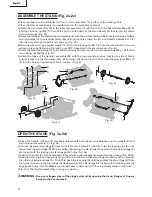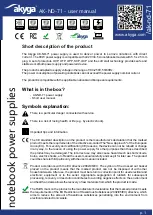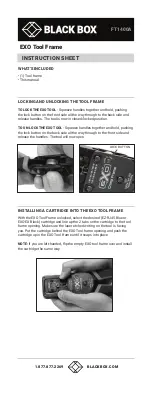
7
English
• DO NOT MODIFY
the plug provided. If it will not fit the outlet, have the proper outlet installed by a
qualied electrician.
• KEEP TOOL DRY, CLEAN, AND FREE FROM OIL AND GREASE.
Always use a clean cloth when
cleaning. Never use brake fluids, gasoline, petroleum-based products, or any solvents to clean tool.
• STAY ALERT AND EXERCISE CONTROL.
Watch what you are doing and use common sense. Do
not operate tool when you are tired. Do not rush.
• DO NOT USE TOOL IF SWITCH DOES NOT TURN IT ON AND OFF.
Have defective switches
replaced by an authorized service center.
• USE ONLY CORRECT BLADES.
Do not use blades with incorrect size holes. Never use blade washers
or blade bolts that are defective or incorrect. The maximum blade capacity of your saw is 10 in. Blades
that do not match the mounting hardware of the saw will run off-center, causing loss of control.
• BEFORE MAKING A CUT, BE SURE ALL ADJUSTMENTS ARE SECURE.
• BE SURE BLADE PATH IS FREE OF NAILS.
Inspect for and remove all nails from lumber before
cutting.
• NEVER TOUCH BLADE
or other moving parts during use.
• FIRMLY MOUNT THE TOOL ON A SECURE SURFACE TO ENSURE ITS STABILITY BEFORE
OPERATING THE TOOL.
• NEVER START A TOOL WHEN ANY ROTATING COMPONENT IS IN CONTACT WITH THE
WORKPIECE.
• DO NOT OPERATE A TOOL WHILE UNDER THE INFLUENCE OF DRUGS, ALCOHOL, OR
ANY MEDICATION.
• WHEN SERVICING
use only identical replacement parts. Use of any other parts may create a hazard
or cause product damage.
• USE ONLY RECOMMENDED ACCESSORIES
listed in this manual or addendums. Use of accessories
that are not listed may cause the risk of personal injury. Instructions for safe use of accessories are included
with the accessory.
• DOUBLE CHECK ALL SETUPS.
Make sure blade is tight and not making contact with saw or workpiece
before connecting to power supply.
• DO NOT ALLOW FAMILIARITY (gained from frequent use of your saw) TO CAUSE A
CARELESS MISTAKE.
Always remember that a careless fraction of a second is sufficient to inflict
serious injury.Use extra caution and keep your attention on your operation when making repetitive cuts.
Reduce the monotony of operations by frequently taking breaks, cleaning up saw dust, or checking the
tool condition.
• FIRMLY BOLT THE SAW TO A WORK BENCH OR LEG STAND
at approximately hip height.
• NEVER OPERATE THE SAW ON THE FLOOR.
• KEEP GUARDS IN PLACE
and in good working order. Blade guard must be in place for all through
cut operations. Reinstall the blade guard immediately after finishing any non-through cut operations
which require removal of the blade guard.
• GUARD AGAINST KICKBACK.
Kickback occurs when the blade stalls rapidly and workpiece is driven
back towards the operator. It can pull your hand into the blade resulting in serious personal injury. Stay
out of blade path and turn switch off immediately if blade binds or stalls.
• USE RIP FENCE.
Always use a fence or straight edge guide when ripping.
• USE AN AUXILIARY FENCE IN CONTACT WITH THE TABLE TOP WHEN RIPPING
WORKPIECES LESS THAN 5/64" (2 MM) THICK.
A thin workpiece may wedge under the rip fence
and create a kickback.
• SUPPORT LARGE PANELS.
To minimize risk of blade pinching and kickback, always support large
panels.
• REMOVE ALL FENCES AND AUXILIARY TABLES
before transporting saw. Failure to do so can
result in an accident causing possible serious personal injury.
• DON’T OVERREACH.
Keep proper footing and balance at all times.
SPECIFIC SAFETY RULES








































